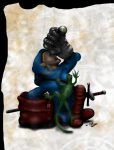Miladoon
First Post
A character concept I was thinking about recently was using an arcane trickster for a sorceress concept. I started thinking about classes and concepts and how you really don't need to play a class. Anyways, I started doodling with the GIMP and ended up with this image:

Do you gamers find it easy to play a concept in 5E? Do you keep your class when you play?

Do you gamers find it easy to play a concept in 5E? Do you keep your class when you play?
